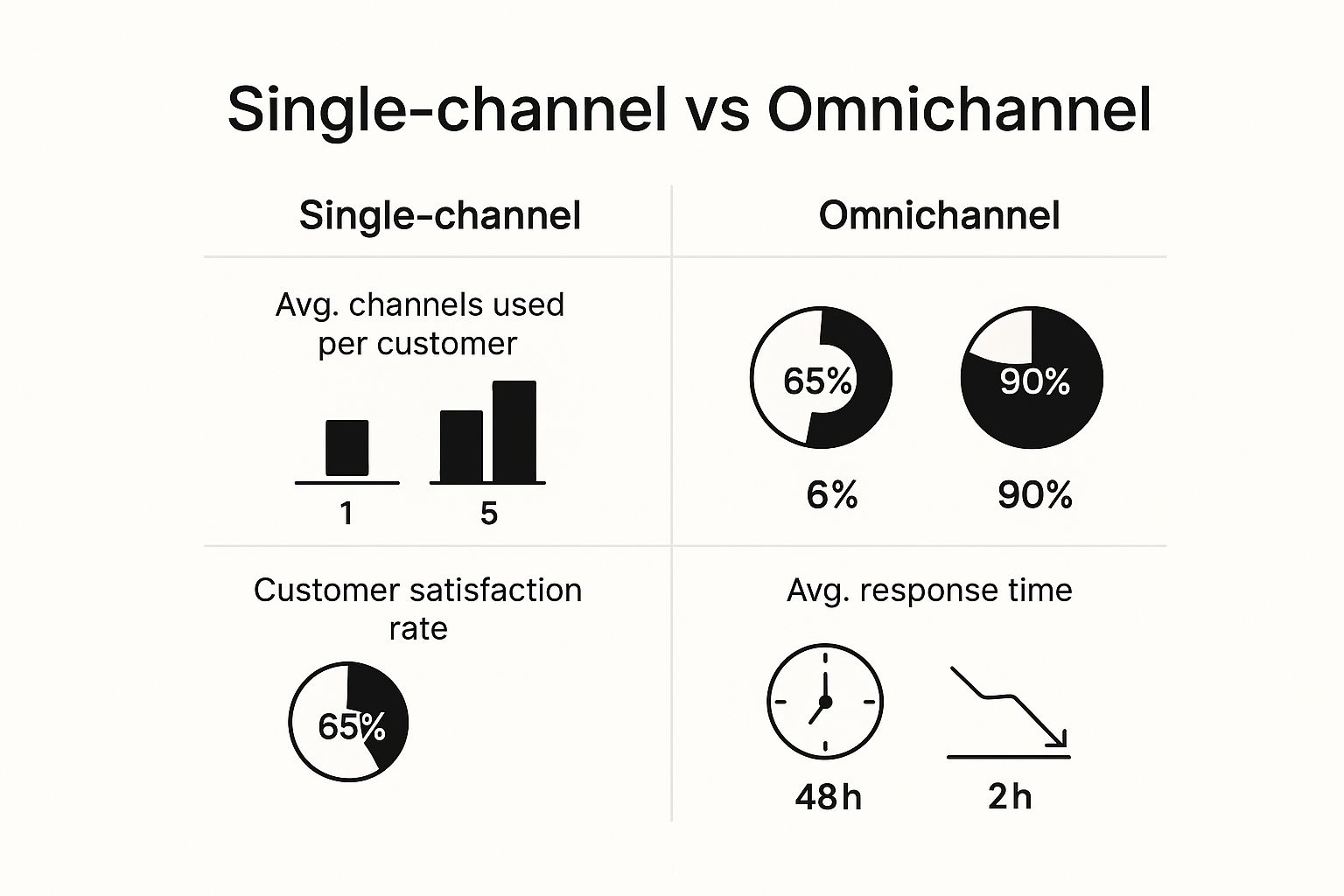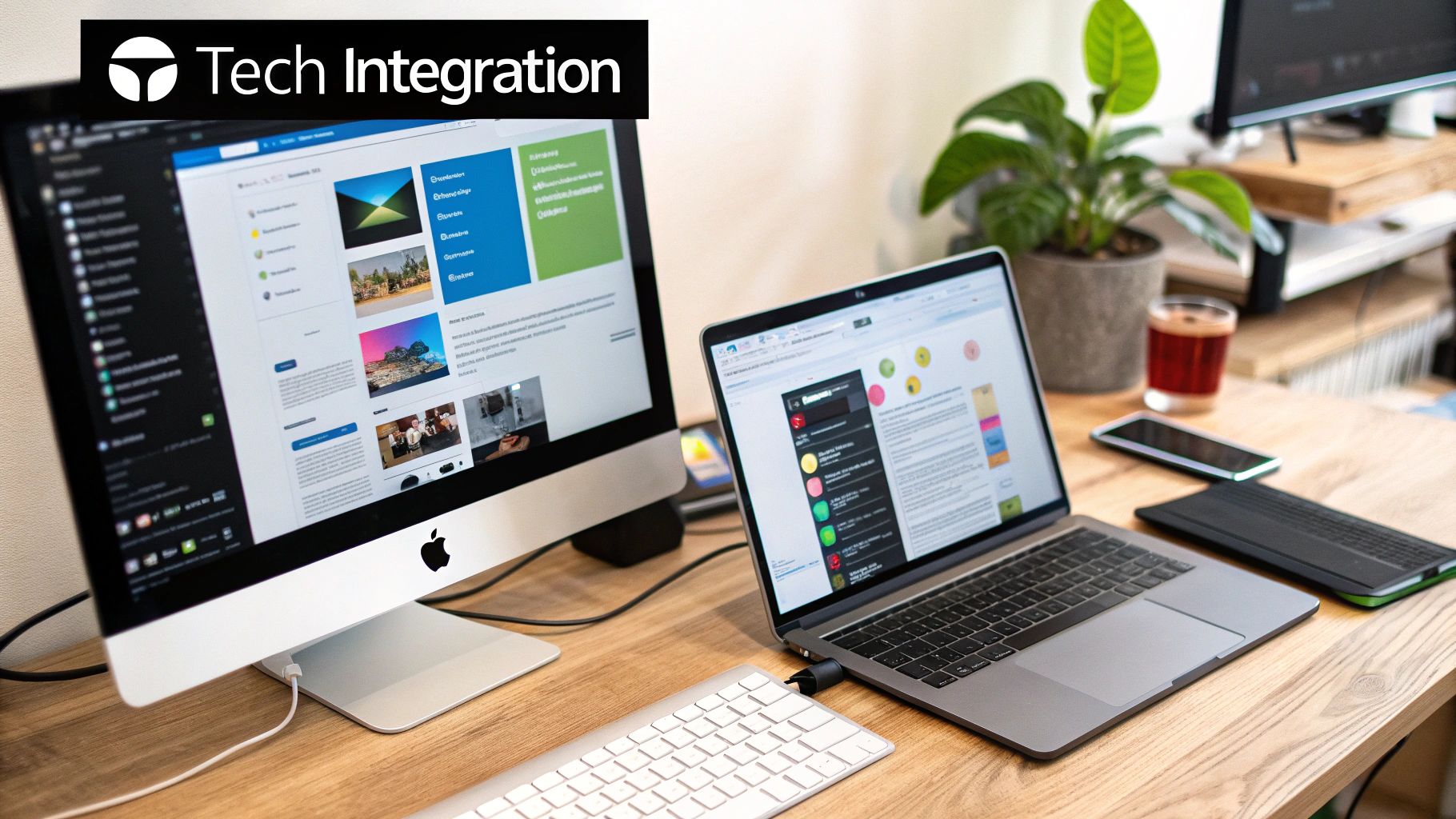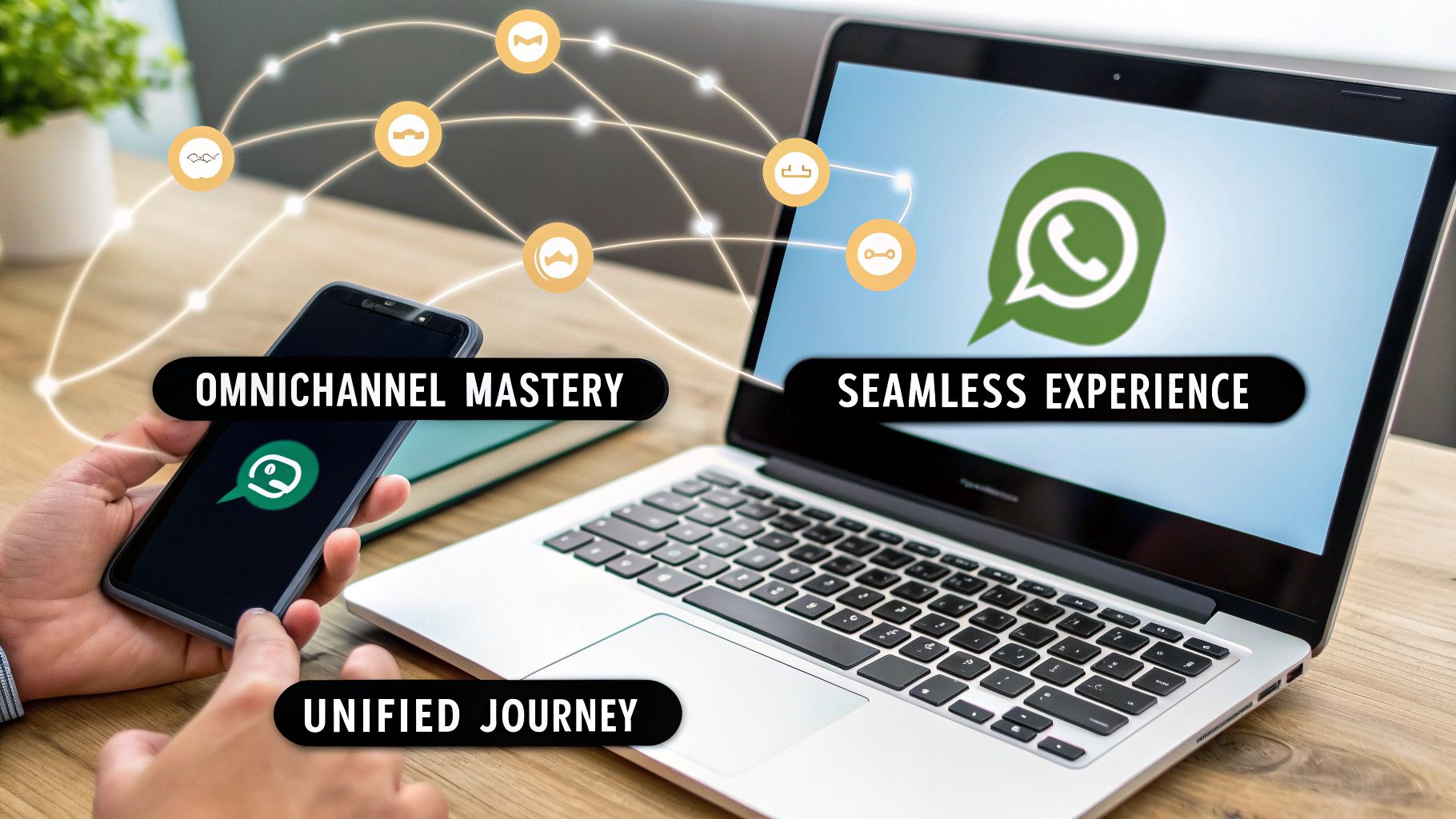Let's be honest. You've set up email, you're active on social media, and you might even have a live chat widget. You're "multichannel," but your customer conversations are all over the place. If a customer sends an Instagram DM, your team tells them to email support, where they have to explain their issue all over again.
This isn't just a minor inconvenience; it's a sales killer. A disconnected experience creates friction, frustrates customers, and leads directly to abandoned carts. In this guide, we'll show you exactly how to transform those separate channels into a seamless omnichannel customer experience that builds loyalty and drives revenue.
Why Your Channels Are Silos, Not a System
From our experience with over 500 Shopify stores, the most common mistake we see is brands thinking that having multiple channels is the same as being omnichannel. It's not.
Think about it from your customer's perspective. They send a DM on Instagram explaining an issue with their order. Your team tells them to send an email. When they do, they have to type out the entire story all over again. Frustrated, they try the live chat on your website, only to be met with a new agent who asks, "How can I help you?"
This isn't just a small inconvenience. It’s a fundamental breakdown in the customer journey that actively damages your brand's reputation. Every time a customer has to repeat themselves, their patience wears thin and their trust in your business erodes. You're creating friction that leads straight to abandoned carts and lost loyalty.
From Disconnected Channels to a Unified Conversation
Making the leap from multichannel to a true omnichannel experience is all about turning those isolated touchpoints into one seamless, ongoing conversation. It’s the difference between making a customer start from scratch and letting them pick up exactly where they left off, no matter which channel they use.
The image below paints a clear picture of how a single-channel or disjointed multichannel setup stacks up against a truly integrated omnichannel strategy.

As you can see, a connected strategy isn't just a "nice-to-have." It results in happier customers and faster support—two of the most critical ingredients for scaling an e-commerce business.
Multichannel vs. Omnichannel at a Glance
This table breaks down the core differences between a standard multichannel approach and a truly integrated omnichannel strategy, highlighting the impact on both the customer and your business.
The takeaway is simple: one approach creates friction, while the other builds loyalty.
The High Cost of a Disjointed Experience
The numbers on this are staggering. Only about 13% of businesses actually carry customer context across every channel. This forces a whopping 56% of customers to repeat their problems over and over.
The stakes are high. For 24% of shoppers, just one bad experience is all it takes for them to walk away and never come back. This isn't just a theoretical problem; it's a daily reality that directly hits your revenue and customer retention.
The Real ROI of an Omnichannel Experience

Let's cut right to it. Moving to an omnichannel model isn't just about giving customers a better feeling; it's a smart, high-impact investment in your brand's bottom line. After working with hundreds of Shopify stores, we've seen it time and again: a genuine omnichannel customer experience acts as a revenue multiplier, not a cost center.
When you link up your channels, you aren't just improving service. You're actually building powerful new pathways to sell. The data is clear—brands with well-oiled omnichannel strategies consistently leave their competitors in the dust.
More Than Just Happy Customers
It all boils down to the numbers. Brands that nail this see real growth in the metrics that actually matter for an e-commerce business. According to Adobe, companies with strong omnichannel customer engagement see a 10% year-over-year revenue growth, a 10% jump in average order value, and a 25% increase in sales close rates.
From our work, the core metrics we see improve most dramatically are:
- Higher Customer Lifetime Value (LTV): When a customer feels seen and understood at every turn—from an Instagram ad to a follow-up on WhatsApp after they buy—they stick around. In our experience, omnichannel customers can have an LTV that's 30% higher than those who only shop through a single channel.
- Increased Average Order Value (AOV): A smooth, connected experience builds trust. And when customers trust you, they feel more comfortable spending more. Personalized recommendations that follow a user from an email to your website and then into a WhatsApp chat lead directly to bigger carts.
- Better Conversion Rates: You're removing all the little frustrations that make people abandon their carts. A customer who can ask a question on live chat and get a quick, helpful answer is far more likely to click "buy" than one who has to send an email into the void and wait.
Turning Conversations Into Revenue
A huge mistake we see brands make is walling off their communication channels from their sales funnel. The whole point of an omnichannel approach is to merge them. Every chat, email, and comment becomes part of a single, fluid journey that's focused on revenue. You can learn more about how this all connects in our guide on ecommerce funnel analysis.
Imagine you know a customer just spent five minutes browsing your sneaker collection. You can then send them a targeted WhatsApp message with a special offer on those very shoes. This isn't creepy; it's helpful. And it works. We’ve had clients boost their conversion rates by over 15% simply by connecting their website browsing data to their WhatsApp campaigns.
Understanding the real ROI here is key. To get the most out of your efforts, it's worth exploring proven strategies to improve marketing ROI to show just how valuable this integrated system is. The goal is to create a setup where every channel works in concert to nudge the customer toward their next purchase, making the whole experience feel personal and effortless. This is how you stop thinking of customer service as a cost and start seeing it as the powerful growth engine it can be.
Your Blueprint for a Powerful Omnichannel Strategy
Alright, we’ve covered the "why." Now, let's roll up our sleeves and get into the "how." Theory is one thing, but you need an actionable plan. This is your blueprint for building a powerful omnichannel customer experience with WhatsApp as the central hub.
Why start with WhatsApp? Simple: it has a 98% open rate. It’s the most direct and personal channel you have to reach your customers. They’re already there, making it the perfect anchor to connect every other touchpoint in their journey.
The strategy that consistently delivers the best results for our clients is built on three crucial pillars. If one is shaky, the whole thing can fall apart.
Pillar 1: Centralize Your Customer Data
This is the absolute foundation. You cannot create an omnichannel experience if your customer data is scattered across different, disconnected tools. You need a single source of truth that shows you who a customer is, what they’ve bought, and how they’ve interacted with you before—no matter which channel they used.
Key Takeaway: You can't offer a seamless experience if your systems are blind to each other. When a customer DMs you on Instagram, your team should see their latest Shopify order and any previous WhatsApp conversations without having to ask.
Your Action Step:Connect your e-commerce platform directly to your main communication channels. As an official Meta Business Partner, Kanal bridges this exact gap by integrating your Shopify store with the WhatsApp Business Platform. This syncs customer profiles, order history, and even browsing behavior into one unified view, giving your team the context they need for truly personal conversations.
Pillar 2: Maintain a Consistent Brand Voice
Your brand shouldn't have a split personality. The way you communicate in an email marketing campaign should feel just like how you chat on WhatsApp or reply on social media. Inconsistency breeds confusion and chips away at trust.
A common mistake we see is brands being buttoned-up and formal on email but super casual on WhatsApp. It makes the whole experience feel disjointed and confusing for the customer.
Your Action Step:Create a simple brand voice guide. This doesn't need to be a 50-page document. Just define the basics:
- Tone: Are you witty, helpful, professional, or playful?
- Common Phrases: How do you greet customers? How do you sign off?
- Emoji Usage: Which emojis fit your brand, and which ones are off-limits?
Share this guide with everyone on your team who talks to customers. This ensures that whether someone gets an abandoned cart reminder or a support reply, it always sounds like it’s coming from your brand. For a deeper dive, our e-commerce marketing playbooks offer templates and examples to help you lock in your brand voice.
Pillar 3: Engineer Seamless Channel Handoffs
This is where the real magic happens. A channel handoff is when a conversation moves from one platform to another—say, from a public Instagram comment to a private WhatsApp chat. A seamless handoff means the customer never has to repeat themselves and the context is never lost.
Imagine a customer asks a detailed question about product sizing in your Instagram comments. Instead of a clunky back-and-forth in a public forum, your team can reply: "Great question! To get you the perfect fit, I've just sent the details over to you on WhatsApp. Just reply there, and we'll get you sorted."
The agent handling the WhatsApp chat already has the full context from Instagram and the customer’s order history from Shopify. The problem gets solved faster, the experience feels polished and premium, and you’ve successfully moved the conversation to a more personal, high-value channel. As you get better at this, it helps to follow a roadmap to implementing business process automation to make these handoffs as smooth as possible. Building these flows is the key to an effective omnichannel customer experience.
Three High-Impact Omnichannel Flows to Launch Today

Alright, you have the blueprint. Now it's time to build something. Theory is one thing, but execution is where real growth happens. After working with over 500 Shopify stores, we've seen firsthand which omnichannel flows deliver the biggest punch right out of the gate.
These aren't abstract ideas; they're battle-tested strategies that consistently recover lost revenue and build serious customer loyalty. Let's walk through how to set them up.
Flow 1: The Multi-Channel Abandoned Cart Recovery
Every e-commerce brand feels the sting of cart abandonment. While email is the go-to recovery tool, its effectiveness is often hit-or-miss. Open rates can be low, and your message is easily buried in a crowded inbox. A truly effective omnichannel approach doesn't just rely on email; it adds a powerful second layer.
The strategy that gets the best results for our clients involves a smart handoff from email to WhatsApp.
Here’s the breakdown:
- Trigger: A customer abandons their checkout. Your existing email platform, like Klaviyo, sends out the first recovery email as usual.
- Condition: You set a timer. If that email is not opened within 60 minutes, it triggers the next action. This delay is key—you're not spamming people who already saw your email.
- Action: This is where Kanal steps in, automatically sending a personalized WhatsApp message. This message pops up right on their lock screen, a space where you have their full attention.
Expert Tip: The goal of the WhatsApp message isn't a hard sell. Keep it helpful and conversational. Frame it as a friendly customer service check-in, not just another marketing blast.
Here's a glimpse of how you can build this exact logic right inside the Kanal platform.

Our drag-and-drop flow builder lets you set up these conditional triggers in minutes. It connects your store's live data to powerful WhatsApp automations without you ever needing to write a single line of code.
Flow 2: The Post-Purchase Review and Upsell
Your work isn’t over when the customer clicks "buy." That post-purchase window is a golden opportunity to strengthen the relationship and set up the next sale. This is where a great omnichannel customer experience shines, creating a conversation that feels natural and adds real value.
Instead of a generic "your order has shipped" email, you can turn that delivery update into a multi-step engagement that builds social proof and drives new revenue.
Here’s the flow:
- Trigger: Your Shopify store flags an order as "Delivered."
- Action 1 (WhatsApp): About two hours after delivery, a friendly WhatsApp message goes out. "Hey [Customer Name], just checking in to make sure you received your package and that everything is perfect!" This small touch shows you care beyond the transaction.
- Action 2 (WhatsApp): A day later, a follow-up message asks for a review. Make it ridiculously easy for them by linking directly to the product page or a review platform like Yotpo.
- Action 3 (WhatsApp): Once they leave a review (or after a few days if they don't), send a final message thanking them and offering a personalized discount code for their next purchase. This rewards them for their time and actively encourages a repeat sale.
This simple sequence can turn a one-time buyer into a loyal advocate and a repeat customer.
Flow 3: The VIP Customer Service Escalation
Not all support tickets are created equal. A classic mistake we see is brands trying to solve complicated problems—like a damaged delivery—in a public forum like Instagram comments. It's slow, messy, and can look unprofessional to other potential buyers.
This flow is all about smoothly moving the conversation from a public space to a private one, creating a premium service experience.
Here’s how it works:
- Trigger: A customer leaves a comment on your Instagram or Facebook post about an order issue (e.g., "My package arrived damaged!").
- Action (Public Reply): Your social media manager immediately replies publicly: "Oh no, we're so sorry to hear that! We want to fix this for you right away. I see you're a customer, so I've just sent you a message on WhatsApp to get your details securely."
- Action (Private WhatsApp): At the same time, you use the Kanal dashboard to find that customer's profile and send them a direct message on WhatsApp. Your support agent already has their entire order history at their fingertips and can resolve the problem quickly without forcing the customer to repeat themselves.
This one move is incredibly powerful. It shows other followers that you're responsive and turns a potentially negative public spectacle into a positive, private resolution. The impact of these seamless, personal interactions is huge. You can explore more data on how omnichannel strategies influence buying behavior to see the full picture.
Common Omnichannel Mistakes to Avoid
https://www.youtube.com/embed/mSxpVRo3BLg
Building a powerful omnichannel customer experience is a game-changer, but it’s easy to make mistakes. After helping hundreds of Shopify stores move from separate channels to one unified system, we’ve noticed the same handful of pitfalls pop up time and again.
The good news? These errors are completely avoidable. If you know what to look for, you can sidestep the common traps and build a strategy that actually works from day one.
Mistake #1: Forgetting Customer Context
This is the number one omnichannel sin. A customer patiently explains their issue on live chat, only to be told to email support… where they have to repeat their entire story from scratch. It sends a clear message that your systems don't talk to each other and that you don't value their time.
The Fix: Your channels must share a single brain. When a customer messages you on WhatsApp, your team needs to see their recent Shopify orders, past email inquiries, and old chat logs—all in one place. A platform like Kanal brings all this data together, giving your team the full picture. Instead of a generic, "How can I help you?", they can say, "I see you were just chatting with us about order #54321. Let's get that sorted out for you."
Mistake #2: Delivering Inconsistent Messaging
Another common misstep is giving your brand a split personality. Your emails are formal, but your Instagram comments are loaded with emojis, and your WhatsApp messages are stuck in the middle. This kind of inconsistency is jarring for customers and makes your brand feel less trustworthy.
The Fix:
- Create a simple voice guide. Define your brand's tone, how you greet customers, and which emojis are on-brand.
- Share it with your team. Make sure every single person who talks to customers is working from the same playbook.
- Use templates. Use pre-approved message templates for common interactions like order updates or support follow-ups. This is a simple way to keep your messaging consistent across every channel.
Mistake #3: Over-Automating Without a Human Touch
Automation is a must for scaling. But leaning on it too heavily, especially on a personal channel like WhatsApp, can make your brand feel cold and robotic. People use WhatsApp to talk to other people, not to get stuck in a frustrating bot menu.
The Fix: Use automation for simple, repetitive tasks, but always give customers a clear and easy way to talk to a real person. Your automated flows should be smart enough to flag a conversation for a human agent when an issue gets complicated or a customer seems frustrated. The goal is to make your team more efficient, not to replace them entirely. Many of our clients use these strategies to power their own customer loyalty program ideas.
Mistake #4: Neglecting Team Training
You can buy the most sophisticated omnichannel platform on the market, but it's useless if your team doesn't know how to use it. Too often, we see brands roll out new tools without properly training their agents on the new workflows or the "why" behind the entire strategy.
The Fix: Make training a top priority. Before you launch anything, make sure your team understands why you’re shifting to an omnichannel approach and how the new tools will help them. Run practice sessions, create cheat sheets, and establish a feedback loop so they can ask questions. Your team is on the front lines—their expertise is your greatest asset.
How to Measure Your Omnichannel Performance

So, you’ve built the flows and connected your channels. Now for the most important question: is it actually working? It’s easy to get fixated on vanity metrics. Sure, WhatsApp's 98% open rate looks fantastic on a report, but it doesn't tell you anything about your return on investment (ROAS).
To really see how your omnichannel strategy is affecting your bottom line, you must track the Key Performance Indicators (KPIs) that directly link your efforts to real revenue and customer happiness. This is how you start making strategic, data-driven decisions.
Key Omnichannel Metrics to Track
Forget surface-level stats. To get a clear, honest picture of what's driving growth, focus on these core KPIs.
By zeroing in on these metrics, you get a 360-degree view that connects your marketing efforts to tangible business outcomes.
Turning Data Into Action
Tracking these numbers is just the first step. The real magic happens when you use that data to constantly refine your strategy.
For example, if you notice that WhatsApp is crushing your email campaigns for cart recovery, that’s a powerful signal. It’s time to lean into it. You might decide to make WhatsApp the primary channel for abandoned carts or test new messaging to squeeze even more performance out of it.
Expert Tip: Don't just look at LTV as one big number. Segment it. Compare the LTV of customers who only use email against those who engage on WhatsApp, Instagram, and email. The difference will starkly illustrate the financial power of your omnichannel setup.
To help you get started, we built a free tool to project your potential gains. Use our customer lifetime value calculator to see how small tweaks can snowball into major revenue growth.
Ultimately, you want to create a continuous feedback loop: launch a flow, measure its performance, and use the insights to make it better. This constant process of testing and refining is what separates thriving brands from the ones that get left behind.
Have Questions? We've Got Answers
We talk to e-commerce founders every single day, and the same questions about building a true omnichannel customer experience pop up time and again. Let's tackle them head-on.
What’s the Real Difference Between Multichannel and Omnichannel?
It’s easy to get these two mixed up, but the distinction is simple. Multichannel is about having a presence on multiple platforms. Omnichannel is about connecting them.
Think of it this way:
- Multichannel is like having separate conversations in different rooms. Your email team is in one room, and your social media team is in another. They aren't talking to each other.
- Omnichannel brings everyone into the same room. The customer has one continuous conversation that flows smoothly from one channel to the next, picking up right where they left off.
From our experience with over 500 Shopify stores, when a customer doesn't have to repeat their issue for the third time, you don't just save a sale—you build trust. An agent on WhatsApp instantly seeing the chat history from your website is a perfect example of this in action.
Do I Need a Big Team to Pull Off an Omnichannel Strategy?
Absolutely not. In fact, it's the opposite. A well-executed omnichannel strategy is designed to make your existing team more powerful, not bigger.
By bringing your most important conversations—from WhatsApp and Instagram DMs—into a single platform like Kanal, you eliminate the chaos of app-switching. A small, dedicated team can manage everything from one shared inbox, armed with the full customer story. This cuts down resolution times and means you can achieve more with the people you already have.
Which Channel Should Be the Anchor for My Strategy?
Time and time again, one channel proves to be the unshakable anchor for a successful omnichannel approach: WhatsApp.
Why? Its 98% open rates are in a league of their own. The communication is direct, personal, and conversational in a way that email and social media just can't match.
WhatsApp is the only place where you can manage the entire customer lifecycle so fluidly. You can send marketing campaigns, recover abandoned carts, and offer instant support, all within a single chat thread. It’s the reliable hub that ties your entire customer journey together, creating a powerful omnichannel customer experience.
Ready to stop losing sales to a disconnected customer journey? Summarize your key takeaways here to reinforce the main points of the article. End with a strong Call to Action. For example:
- Centralize Your Data: A single view of the customer is non-negotiable.
- Engineer Seamless Handoffs: Move conversations between channels without losing context.
- Start with High-Impact Flows: Focus on cart recovery and post-purchase engagement first.
Ready to build your own high-converting flows? Install Kanal on your Shopify store today or get a personalized demo to see how we turn customer conversations into revenue.



